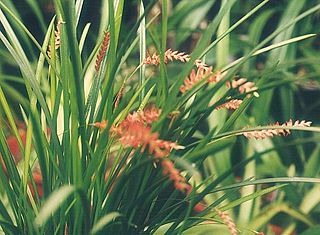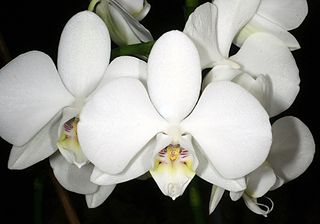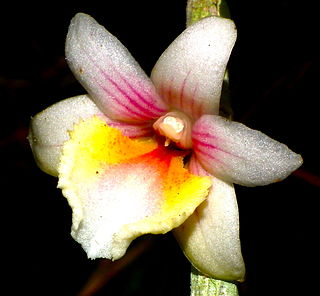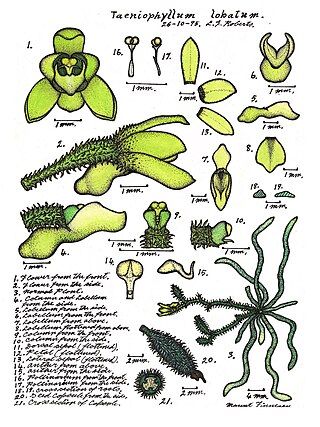
Robiquetia minimiflora, or the tiny-flowered abdominea, is a very rare monopodial epiphytic orchid species. It was previously known as the Abdominea minimiflora. It is distributed from Thailand to the Malay peninsula, Java, and the Philippines.

Dendrochilum was a genus of epiphytic, lithophytic and a few terrestrial flowering plants in the orchid family (Orchidaceae). It is now considered to be a synonym of Coelogyne Lindl. The name of this genus was derived from Ancient Greek words dendron ("tree"), and either cheilos ("lip") or chilos, alluding to either the flowers' large lip or to their epiphytic growth. These orchids are popular among fans of non-traditional orchid curiosities.

Ophrys insectifera, the fly orchid, is a species of orchid and the type species of the genus Ophrys. It is remarkable as an example of the use of sexually deceptive pollination and floral mimicry, as well as a highly selective and highly evolved plant–pollinator relationship.

Phalaenopsis amabilis, commonly known as the moon orchid, moth orchid, or mariposa orchid, is a species of flowering plant in the orchid family Orchidaceae. It is widely cultivated as a decorative houseplant. It is an epiphytic or lithophytic herb with long, thick roots, between two and eight thick, fleshy leaves with their bases hiding the stem and nearly flat, white, long-lasting flowers on a branching flowering stem with up to ten flowers on each branch.

Dendrobium nobile, commonly known as the noble dendrobium, is a member of the family Orchidaceae. It has become a popular cultivated decorative house plant, because it produces colourful blooms in winter and spring, at a time when little else is in flower. It is also one of the 50 fundamental herbs used in traditional Chinese medicine, known as shí hú or shí hú lán. Dendrobium nobile is one of the most widespread ornamental members of the orchid family. Its blooms are variegated in colour, shading from white through pink and purple, and the many different cultivated varieties produce different sized and coloured blooms.

Angraecum conchiferum is a species of orchid found in Knysna and Tsitsikamma forests.

Microsaccus is a genus of flowering plants from the orchid family, Orchidaceae. It is native to Southeast Asia.

Papillilabium beckleri, commonly known as the imp orchid, is the only species in the genus Papillilabium from the orchid family, Orchidaceae. It is a small, epiphytic orchid with many thin roots, between two and six linear leaves and up to eight pale green or brownish flowers. The flowers are fragrant, produce nectar and have a warty labellum. It grows on shrubs and trees in humid places and near streams and is found between south-east Queensland and the Sydney region in New South Wales.
Rhinerrhiza divitiflora, commonly known as the raspy root orchid, is the only species in the genus Rhinerrhiza from the orchid family, Orchidaceae. It is an epiphytic or lithophytic orchid with usually only a single stem, many flat, raspy roots, between two and six leathery leaves and up to sixty pale orange flowers with red spots and blotches. The sepals and petals are narrow, thin and pointed. It mainly grows on rainforest trees and is found between the Atherton Tableland in Queensland and the Hunter River in New South Wales.
Schistotylus purpuratus, commonly known as purple sprites, is the only species in the genus Schistotylus from the orchid family, Orchidaceae. It is a small epiphytic orchid with up to six crowded, linear leaves and up to ten cup-shaped, pale green flowers with purple marking and a mostly white labellum. It grows in rainforest and swampy heath in eastern Australia.

Dendrobium boosii, or Ronny Boos' dendrobium, is a species of plant in the family Orchidaceae endemic to the Philippines.
Oeceoclades flavescens is a terrestrial orchid species in the genus Oeceoclades that is endemic to northeastern Madagascar. It was first described by the French botanists Jean Marie Bosser and Philippe Morat in 2001. The type specimen was collected in 1954 from the wet undergrowth of a coastal forest near Maroantsetra; it is the only known collection of this species. The specific epithet flavescens refers to the pale yellow flowers.
Saccolabiopsis armitii, commonly known as the spotted pitcher orchid, is an epiphytic orchid from the family Orchidaceae. It has a short stem, coarse, wiry roots, between three and six crowded, curved leaves and up to fifty yellowish green flowers with red markings and a white labellum. It usually grows in coastal scrub to rainforest in New Guinea and tropical North Queensland, Australia.
Saccolabiopsis rectifolia, commonly known as the tiny pitcher orchid, is an epiphytic orchid from the family Orchidaceae. It has a short stem, thin roots, between three and six crowded leaves and up to fifteen cup-shaped green flowers with a white, purple spotted labellum. It grows on the thinnest outer branches of rainforest trees in tropical North Queensland, Australia.

Taeniophyllum lobatum, commonly known as the yellow ribbonroot, is a species of leafless epiphytic or lithophytic orchid that forms small clumps. It has short stems, flattened pale to greyish green roots pressed against the substrate on which it is growing and usually two pale to bright yellow flowers. It only occurs in tropical North Queensland.

Pelatantheria insectifera is a species of orchid occurring in Thailand, Laos, India. The species is a long-stemmed epiphytic herb. The small flowers have a relatively large, fleshy, bright pink labellum. The specific epithet "insectifera", meaning "insect bearing", refers to the flowers, which are indicated to resemble an insect. Thus, attraction of pollinators by means of sexual deception is implied, but to date no pollinator has been published. The flowers are produced from September to October on subsessile racemes, which are shorter than the leaves. The plants are almost entirely self-incompatible, but a small percentage of self-pollination events may be successful. After pollination the colour of the labellum changes from pink to red and the sepals and petals begin to close.

Phalaenopsis difformis, also known as the dark brown Phalaenopsis, is a species of epiphytic orchid native to Assam, Borneo, China South-Central, China Southeast, East Himalaya, Laos, Malaya, Myanmar, Bangladesh, Nepal, Sumatera, Thailand, Vietnam and West Himalaya.

Vanda dives is a species of epiphytic orchid native to Vietnam and Laos.

Phalaenopsis kapuasensis, also known as the Kapuas Hulu Phalaenopsis, is a species of orchid endemic to Borneo. The specific epithet kapuasensis refers to the indonesian locality Kapuas Hulu, from which the type specimen was obtained.

Maxillaria aureoglobula, the golden globe maxillaria, is a species of epiphytic orchid native to Costa Rica, Colombia, Venezuela, and Brazil. Originally this species was included in the species Maxillaria rufescens but in 2002 it was described a distinct species by Eric Christenson. The type specimen was collected in Columbia although the precise location is unknown.














